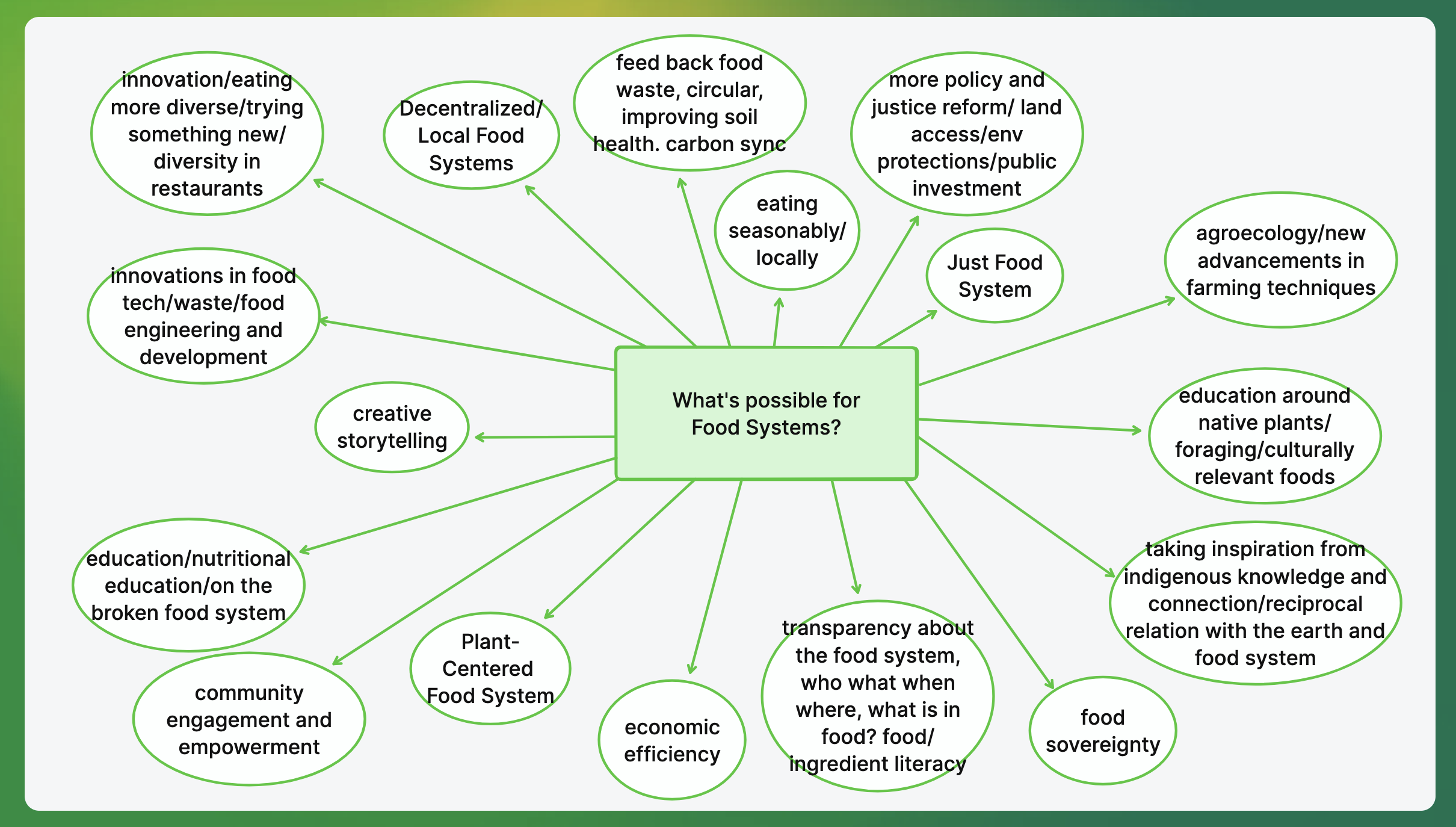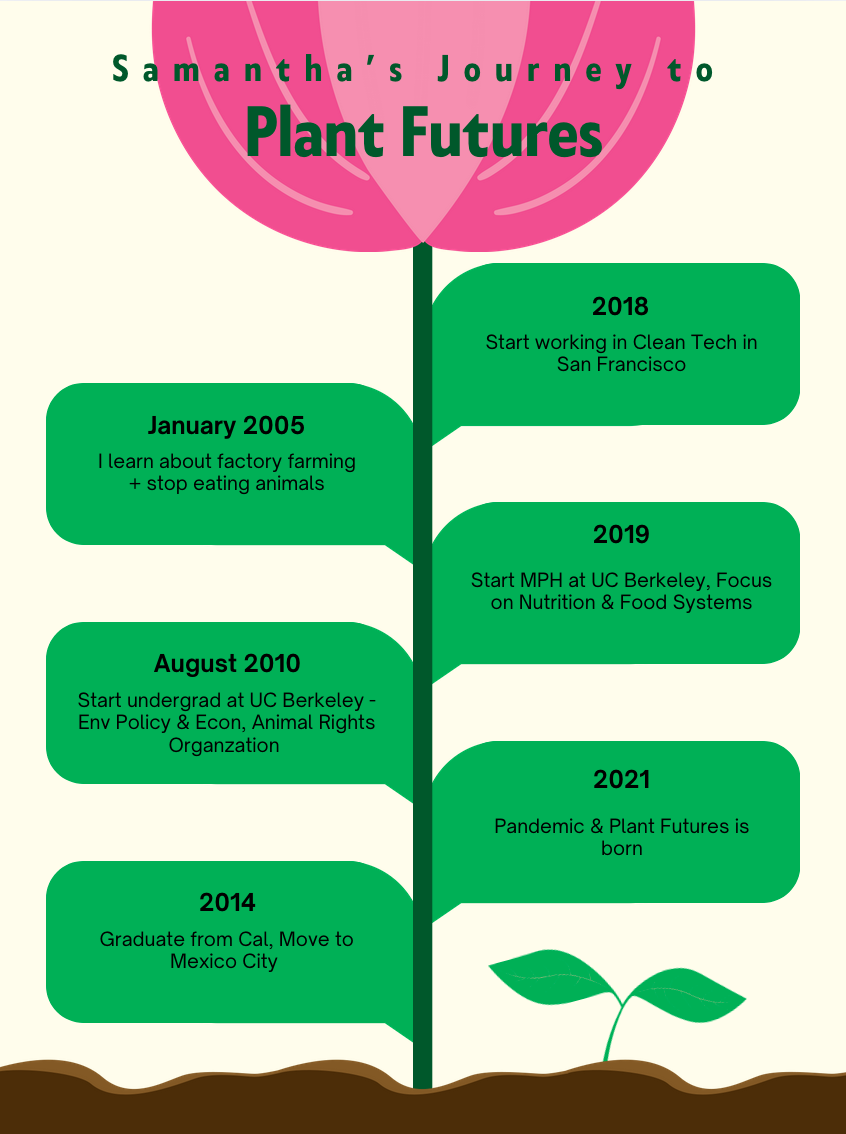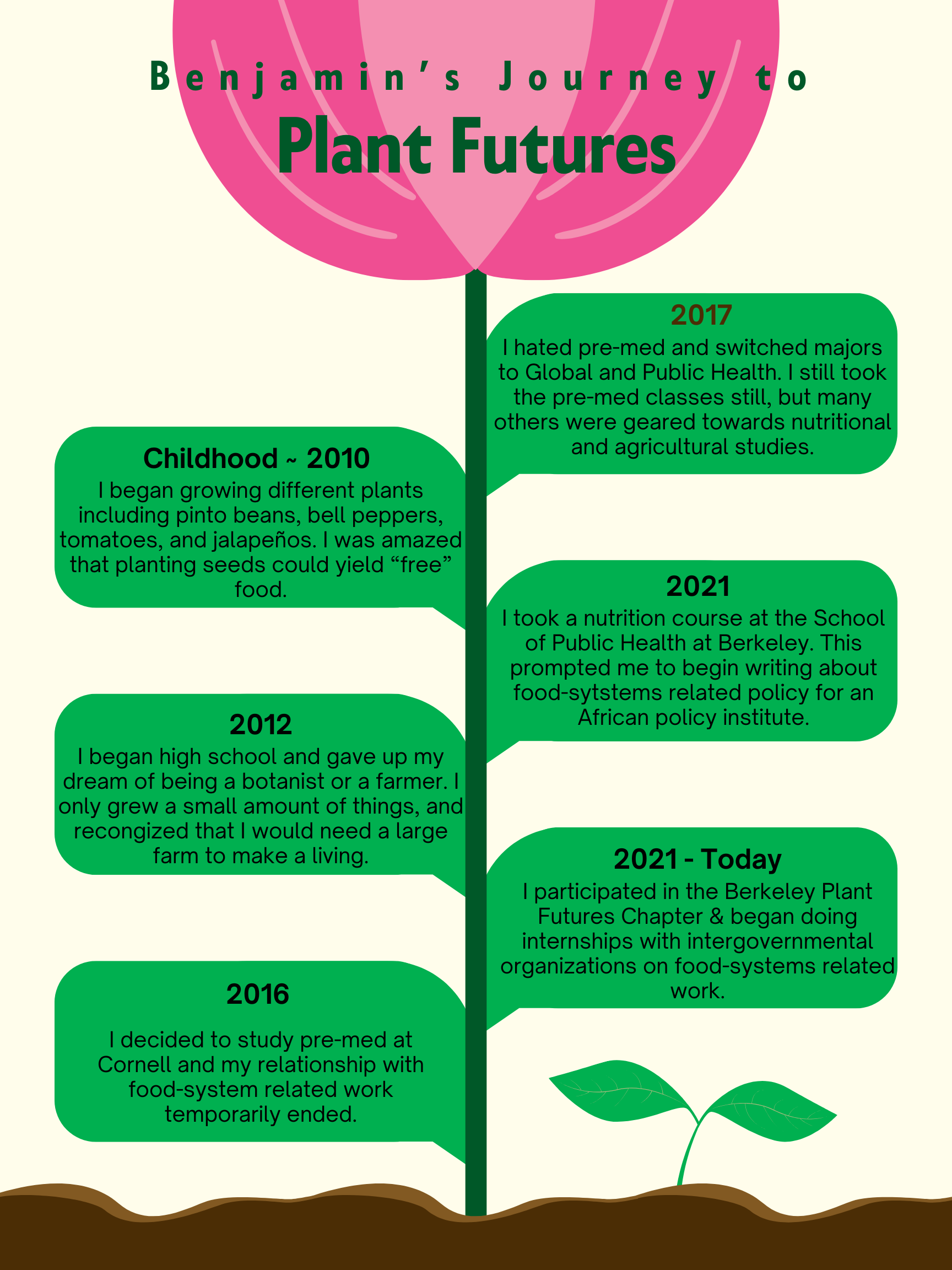Teaching Toward Plant-Centered Futures: Reflections from the Classroom
Where do we go to learn about food systems today? Not just nutrition facts or agricultural policy in isolation, but the big questions: How does food shape our cultures and communities? What does it mean to eat ethically in the face of climate change? How do we connect the dots between what’s on our plates and the systems that sustain or exploit people and the planet?
These questions came alive in the very first session of our 8-week Plant Futures summer crash course “Foundations of a Plant-Centered Future”. Together with students from across the country, we built a collective map of “What’s Broken in our Food System” and “What’s Possible.” Their ideas filled the screen with urgency and imagination: from animal rights abuses, monoculture, and food insecurity, to possibilities like community engagement, agroecology, and food sovereignty.
What’s broken?
What’s possible?
What struck us wasn’t just the accuracy of their diagnoses, but the breadth of their vision. From over ten universities across the U.S., these students carved out 16 hours from their busy summers (balancing internships, jobs, and research) to dive into these complex questions. They came from disciplines as wide-ranging as environmental studies, political science, marine policy, biochemistry, and sustainable business. But what they brought was even more valuable: their personal stories, their curiosities, and a shared desire to be part of building a better food future.
From the start, we were clear about our intention: food systems education cannot be static or siloed. It must be alive, responsive to the moment, connected to culture, and grounded in the legacies and voices of those actively shaping food systems today, not just case studies pulled from the past. This conviction is what led us to co-teach the course. And it became clear right away: the most important lessons aren’t found in a textbook at all, but in the stories, challenges, and possibilities we carry into the room together.
Returning to the Roots, While Growing New Branches
For us as co-teachers, this course was more than a syllabus, it was a convergence of our histories, talents, and visions for what food systems education could be.
“For me, this was a homecoming,” Sam reflected. Plant Futures itself began as a student-led course at UC Berkeley. Co-teaching this summer felt like coming full circle: a chance to return not just with memories, but with lived lessons from growing a student project into a global initiative. Sam brought that systems-change lens into the room, sharing stories of real campaigns, partnerships, and communities that showed students how abstract ideas take root in practice.
At the same time, Darleen drew from a decade of experience designing both online and in-person courses. “My focus was on creating a reciprocal space,” she explained. “The subject matter is delicate and often deeply personal; we’re not used to talking about the emotions tied to food. I wanted students to feel guided and supported without being confined.”
One of the most powerful examples of this convergence was our “Journey to Plant Futures” activity. Darleen adapted a visual template to hold Sam’s personal story.
As Sam narrated her journey, the graphic became a living illustration of how roots and branches shape a path: early convictions feeding into education, professional choices, and eventually the creation of a movement. Students then built their own journeys using the same template, reflecting on the formative experiences, challenges, and inspirations that had brought them to this course.
This activity encapsulated the balance we sought throughout the class: Sam modeling systems change as a lived, evolving practice, and Darleen holding space for students to translate that model into their own lives. Together, roots and branches intertwined to create an environment where past legacies, present struggles, and future visions could all take shape in dialogue.
The Power of Dialogue: From Personal Plates to Systemic Change
In designing this course, we wanted to make clear that knowledge doesn’t only come from textbooks or academic research, it also comes from our own experiences, our communities, and our cultures. These are vital sites of knowledge production, especially in conversations about food and sustainability.
One way we emphasized this was through the Healing through Plants: Plant-Centered Medical Traditions Around the World Zine. Each student contributed a an entry introducing a traditional medicine system rooted in plants, nature, and holistic healing. The entries showed how communities across the globe have long recognized that food is medicine: how plants carry nourishment, memory, spirit, and connection to land. Collectively, the entries formed a zine that honored ancestral wisdom and demonstrated how eating plant-based today can be seen as a continuation of these healing practices.
This emphasis on lived and ancestral knowledge came alive again in our session with Roberta Sequi from the Hopi Foundation and Natwani Coalition. Roberta shared the Hopi way of life, where agriculture is more than food production, it is also ceremony, reciprocity, and identity. She invited students to see farming as an expression of interdependence with the land, and to recognize that Indigenous worldviews offer not only techniques but entire frameworks for sustainability.
In response, students built a “wonder wall” of questions and curiosities about Hopi values, cultural transmission, regenerative agriculture, and the global climate crisis.
The wonder wall revealed how students were learning to approach Indigenous knowledge with humility, openness, and respect. Instead of looking for quick fixes, they began asking deeper questions about cultural continuity, adaptation, and sovereignty.
Together, the Healing through Plants project and Roberta’s session made visible the power of centering community and ancestral knowledge in the classroom. They reminded us and our students that imagining food futures means recognizing that many of the answers already exist in the wisdom that has sustained life for generations.
Experiences like the Healing through Plants project and our dialogue with Roberta Sequi reaffirmed our belief that food systems education must look and feel different from conventional curricula. Too often, formal education lags behind the urgency of the moment. Knowledge is scattered across disciplines or stripped of its cultural and political context. What gets left out are the voices of those who live food systems every day: farmworkers, Indigenous leaders, healers, and young people who are reimagining futures in real time.
In this course, we set out to build something different: education that is accessible, experimental, and student-centered. By drawing on the Plant Futures network of activists, educators, and professionals, and by inviting students’ own cultures and experiences into the curriculum, we aimed to create a learning space that reflected the realities of food systems now. Not just theory, but practice. Not just analysis, but imagination.
The most rewarding part of this approach was seeing how students responded. Their reflections at the end of the program revealed how even within just eight weeks, perspectives shifted and confidence grew. One student put it succinctly: “I used to see food mainly as just personal choice, but I now understand it as a powerful driver of climate resilience, equity, and community wellbeing.”
Others shared how this new way of learning gave them language to articulate their values, community to support their choices, and even inspiration to reimagine their career paths in real time.
For us, these reflections underscored a central truth: education can be a lever for systemic change. When students reframe how they see food, they carry that shift into their lives, their careers, and their communities.
In other words, building the education we dream about is inseparable from building the food systems we dream about. By treating curriculum as a living ecosystem that is adaptive, interdisciplinary, and rooted in experience, the classroom becomes more than a place of learning. It becomes a catalyst for transformation.
A New Chapter for Food Systems Education
This crash course was a powerful demonstration, a potent exercise in world-building. For eight weeks, we built a microcosm of the food system we wish to see: one centered on dialogue, reciprocity, and the rich, human stories behind what we eat.
In doing so, we witnessed a profound parallel transformation. As we co-created this space with students, it became clear that building a new food future and building a new model of learning are one and the same endeavor. You cannot have one without the other. The old, siloed models of education cannot produce the systems-thinking, empathetic leaders our world needs.
This experience showed us that the transformation of our food systems is inextricably linked to a transformation in learning itself. It must be an education that is as dynamic, interconnected, and alive as the ecosystems it studies. It must connect across generations and disciplines, honoring lived experience as a vital form of expertise.
We are not just teaching about food. We are practicing a new way of learning that cultivates the mindsets and collective capacity to redesign our world. This is an education model built by the movement, for the planet.
What we witnessed this summer was not just curiosity, but a deep desire from students to connect, to question, and to take action. This exercise in world-building left us a blueprint for how education can nurture agency, confidence, and imagination.
This is how we begin to learn our way into a new future: by creating spaces that are alive, connected, and grounded in practice. We are excited to keep learning together, more to come soon.
— Sam & Darleen






